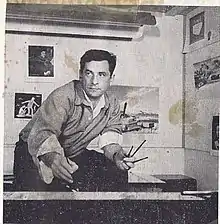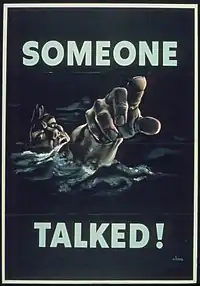Fritz Siebel | |
|---|---|
 | |
| Born | Frederick Siebel December 19, 1913 |
| Died | December 27, 1991 (aged 78) |
| Known for | illustration, design |
Frederick "Fritz" Siebel (December 19, 1913 – December 27, 1991) was an Austrian American illustrator, well known for his award winning World War II poster "Someone Talked"[1][2] and his illustrations for the children's book Amelia Bedelia by Peggy Parish.[3]
Life
Early years
Siebel was born in Vienna to Czechoslovakian parents.[4] During his childhood he and his siblings spent summers at the family hops farm in Czechoslovakia.[5] He studied Illustration and stage design at the Kunstgewerbeschule Vienna (now the University of Applied Arts Vienna), after which, because of his dual citizenship, he was drafted to the Czech army where he served from 1934 to 1936.[6]
Immigration to the USA
In 1936 Siebel immigrated to the United States and was joined by his family in 1937, and they settled in New York City. The other relatives who remained in Europe perished in the Holocaust.[7]
Death
Frederick Siebel died in New York City on December 27, 1991.[7]
Work as a Graphic Artist
Early USA Years
In NYC, after his immigration, Siebel made a living illustrating posters and other advertising material for the Paramount Pictures movie studio. He also worked as a demonstrator of Austrian skiing techniques at Saks Fifth Avenue.[5]

WWII and the "Someone Talked" poster
During World War II Siebel served in the United States Army between 1941 and 1943.[8][9]
Before the war, in 1938, he submitted a poster to a national competition for posters on the subject of national security for which First Lady Eleanor Roosevelt was a judge.[10][1] His entry, "Someone Talked", won several awards and was only published in 1942, during the war.[9]
Trivia
The poster was chosen by David Mamet as an "ominous World War II propaganda poster"[11] on the wall in the workplace in his 1997 neo-noir movie "The Spanish Prisoner".
Advertising and Magazines
Following his work at Paramount Pictures and the success of "Someone Talked", there was a growing demand for Siebel's work, and he began creating illustrations for advertisements and for magazines, working among others with Collier's Magazine, Holiday Magazine and The Saturday Evening Post.[5] Among others, he created ads for Ballantine Beer[12][13] and Schlitz beer.[14]
Mr. Clean
In 1957, Siebel was contracted by the Tatum-Laird advertising agency to create a mascot figure for the new Procter & Gamble cleaning product "Mr. Clean". The result was the now world-wide familiar smiling bald man with an earring in his left ear, dubbed "Master Proper" in German-speaking countries, "Mastro Lindo" in Italy, "Monsieur Propre" in France, "Don Limpio" in Spain and "Pan Proper" in Poland. As part of the deal, he gave up all rights to this creation and thus was not credited for it, the copyright attributed solely to Procter & Gamble.[7][5]
Children's book illustration
In 1958, Siebel began illustrating children's books.[7][5] The first two, best-seller "A Fly Went By"[15] and "Stop that Ball!"[16] were written by Mike McClintock and were published in the Random House "Beginner Books" series that was co-founded by Phyllis Cerf with Dr. Seuss, and Seuss' wife Helen Palmer Geisel. In 1962 he illustrated Dorothy Kunhardt's "Dr. Dick".[17] This book was published by Harper and Row (now HarperCollins), who also published his most well known children's book – Amelia Bedelia by Peggy Parish.
Design Company
In the 1960s Siebel founded the Frederick Siebel Associates company, to provide "creative design for integrated programs of packaging, store display, and other sales-related materials."[18] The company was later renamed "Siebel Marketing Company", and in 1998 was merged with the Chicago marketing agency Upshot under Ha-Lo Industries.[19]
References
- 1 2 Pelkofsky, Julia (December 18, 2014). "LOOSE LIPS SINK SHIPS". Cooper Hewitt. Retrieved October 16, 2020.
- ↑ "Someone talked! / Siebel". Library of Congress. Retrieved October 3, 2020.
- ↑ "Fritz Siebel". HarperCollins Publishers. Retrieved October 3, 2020.
- ↑ "Fritz Siebel Papers, Children's Literature Research Collection, University of Minnesota Libraries". University of Minnesota. Retrieved March 23, 2021.
- 1 2 3 4 5 Peng, Leif (October 11, 2012). "Fritz Siebel: "never felt that he needed to be recognized... but he was always proud."". Today's Inspiration. Retrieved October 3, 2020.
- ↑ "Original U.S. WWII 1942 Someone Talked OWI Propaganda Poster by Frederick "Fritz" Siebel". International Military Antiques.
- 1 2 3 4 Bergmann, Hubert. "Meister Propers Wiener Wurzeln: Fritz Siebel, Schöpfer der Werbe-Ikone Mr. Clean". Austrian Academy of Sciences. Retrieved October 16, 2020.
- ↑ "Fritz Siebel". Penguin Random House. Retrieved October 16, 2020.
- 1 2 Cooper Hewitt, Smithsonian Design Museum. "Poster, Someone Talked!, 1942". Cooper Hewitt. Retrieved 16 October 2020.
- ↑ "Equilibrium Records to Release "Someone Talked! Memories of World War II" with Grammy winner William Bolcom, Joan Morris, Robert White, Hazen Schumacher (under "About the Cover Art: 'Someone Talked!' by Frederick Siebel")". Cision PRWeb. October 15, 2009. Retrieved March 24, 2021.
- ↑ Kevin, Curtis (November 2019). "The Code of the Con | The Spanish Prisoner (1997)". Bright Wall/Dark Room. Retrieved 27 March 2021.
- ↑ "Magazine Ad For Ballantine Beer, Cut Away View of Ski Lodge illustration, Frederick Siebel, 1954". Magazines, Ads & Books Store.
- ↑ "Magazine Ad For Ballantine Beer, Bottle in Tub, Illustration People Bowling Frederick Siebel, 1953". Magazines, Ads & Books Store.
- ↑ "Magazine Ad For Schlitz Beer, Bowling Night, Schlitzframe, Be A Schlitzer, 1957, Double Page Ad". Magazines, Ads & Books Store. Retrieved October 3, 2020.
- ↑ "A Fly Went By". Retrieved October 17, 2020.
- ↑ "Stop that Ball!". Retrieved October 17, 2020.
- ↑ "Dr. Dick". Retrieved October 17, 2020.
- ↑ "News". Industrial Design. 16: 28. 1969.
- ↑ Elliot, Stuart (December 22, 1998). "THE MEDIA BUSINESS: ADVERTISING -- ADDENDA; Siebel Group Sold To Ha-Lo Industries". New York Times. Retrieved March 23, 2021.